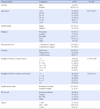Abstract
Purpose
The purpose of this study was to investigate the factors influencing nurse turnover intention in small and medium sized hospitals in the metropolitan area.
Methods
A cross-sectional survey design was used. A questionnaire was distributed to the nurses in small and medium sized hospitals. The data of 209 nurses was analyzed using t-test, ANOVA, Pearson correlation coefficient and multiple regression.
Figures and Tables
Table 2
Degree of Professionalism, Job Involvement, Organizational Commitment, Practice Environment, and Turnover Intention (N=209)

Table 3
Professionalism, Job Involvement, Organizational Commitment, Practice Environment, and Turnover Intention according to General Characteristics of Participants (N=209)

References
1. Jeong EJ, Chae GS, Noh WJ, Park MM, Cho UY, Kim HJ. A Survey on hospital nursing staffing. Business report for Hospital Nurses Association. Seoul: Hospital Nurses Association;2013.
2. Kim YM, Jeon KJ, Kim JY. Analysis of trends in hospital nursing staffing and working conditions. Business Report for Hospital Nurses Association. Seoul: Hospital Nurses Association;2011.
3. Center for Health and Social Change. The changing structure for quality improvement of health services in hospital-focused on nursing workforce. Seoul: The Korean Public Service Workers Union;2008.
4. Lee YT, Kim JD, Lee TH, Kang DW, Park JA. A Survey on the demand and supply of nursing workforce and the grade system of nursing management fee. Seoul: Korea Health Industry Development Institute;2008.
5. Han YH, Sohn IS, Park KO, Kang KH. The relationships between Professionalism, Job involvement, organizational commitment and turnover intention among clinical nurses. J Korean Clin Nurs Res. 2010; 16(2):17–31.
6. Nam MH, Kwon YC. The relationship between better life index, nursing performance and intents to leave among hospital nurses. J Digit Converg. 2012; 10(9):417–427.
7. Jeong JH, Kim JS, Kim KH. The risk factors influencing turnover intention of nurses. J Korean Acad Nurs Adm. 2008; 14(1):35–44.
8. Yoo SJ, Choi YH. Predictive factors influencing turnover intention of nurses in small and medium-sized hospitals in Daegu city. J Korean Acad Nurs Adm. 2009; 15(1):16–25.
9. Kang KN. Factors influencing turnover intention of nurses in small-medium sized hospitals. J Korean Acad Nurs Adm. 2012; 18(2):155–165.
10. Kwon JO, Kim EY. Impact of Unit-level nurse practice environment on nurse turnover intention in the small and medium sized hospitals. J Korean Acad Nurs Adm. 2012; 18(4):414–423. http://dx.doi.org/10.11111/jkana.2012.18.4.414.
11. Kim SM, No YJ, Kim JL, Park JS. A study on expand jobs and improve working condition in health care in health and medical industry. Seoul: Economic and Social Development Commission;2010.
12. Lee TW, Kang KH, Ko YK, Cho SH, Kim EY. Issues and Challenges of Nurse Workforce Policy: A Critical Review and Implication. J Korean Acad Nurs Adm. 2014; 20(1):106–116. http://dx.doi.org/10.11111/jkana.2014.20.1.106.
13. Baek HC, Kim-Godwin YS, Yeoun S. Translation and validation of Korean version of Hall's professionalism inventory. J Korean Acad Nurs Adm. 2007; 13(4):509–515.
14. Lee MH. Role Stress, Organizational commitment and job involvement in clinical nurses. J Nurs Acad Soc. 1996; 26(2):467–482.
15. Kanungo RN. Measurement of job and work involvement. J Appl Psychol. 1982; 67(3):341–349.
16. Mowday RT, Steers RM, Poter LW. The measurement of organizational commitment. J Vocat Behav. 1979; 14:224–247.
17. Cho EH, Choi MN, Kim EY, Yoo IY, Lee NJ. Construct validity and reliability of the Korean version of the practice environment scale of nursing work index for Korean nurses. J Korean Acad Nurs. 2011; 41(3):325–332.
18. Lawler EE. Satisfaction and behavior. In : Hackman JR, Lawler EE, Porter LW, editors. Perspectives on behavior in organizations. 2nd ed. New York: McGraw Hill;1983. p. 78–87.
19. Park HS. Relationship between perceived nursing care role orientation, job characteristics, and turnover among nurses [master's thesis]. Seoul: Department of Public Health, The Graduate School of Yonsei University;2002.
20. Oh EH, Chung BY. The effect of empowerment on nursing performance, job satisfaction, organizational commitment, and turnover intention in hospital nurses. J Korean Acad Nurs Adm. 2011; 17(4):391–401.
21. Lake ET, Friese CR. Variations in nursing practice environments relation to staffing and hospital characteristics. Nurs Res. 2006; 55:1–9.
22. Kim MA, Park KO, You SJ, Kim MJ, Kim ES. A survey of nursing activities in small and medium-size hospitals: reasons for turnover. J Korean Clin Nurs Res. 2009; 15(1):149–165.
23. Han SS, Sohn IS, Kim NE. New nurse turnover intention and influencing factors. J Korean Acad Nurs. 2009; 39(6):878–887. http://dx.doi.org/10.4040/jkan.2009.39.6.878.
24. Lee YS, Jung MS. Relationship of followership to organizational commitment, job satisfaction, turnover intention, and customer orientation in nurses. J Korean Acad Nurs Adm. 2013; 19(2):187–195. http://dx.doi.org/10.11111/jkana.2013.19.2.187.
25. Kim MR, Seomun GA. Relationships among burnout, job satisfaction, organizational commitment and turnover intention to resign in hospital nurses. Korean J Occup Health Nurs. 2013; 22(2):93–101. http://dx.doi.org/10.5807/kjohn.2013.22.2.93.




 PDF
PDF ePub
ePub Citation
Citation Print
Print





 XML Download
XML Download